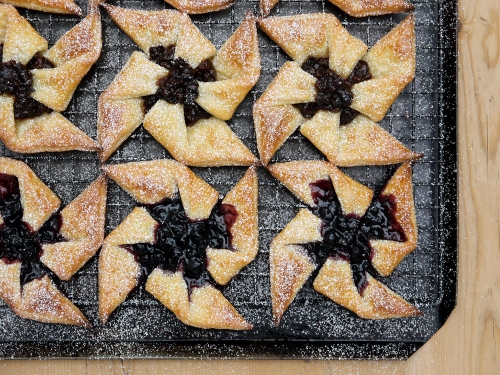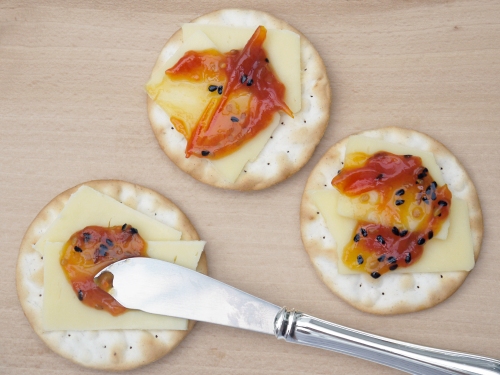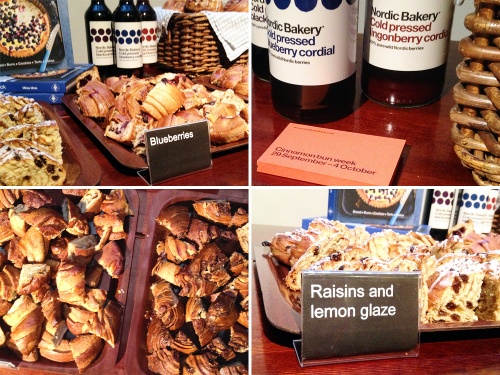It is nearly Christmas, so we really need to have something with chocolate. On today’s cookie platter we have Hausfreunde, which are little German cookies made of shortbread, filled with apricot jam and marzipan, and topped with dark chocolate and walnuts.

I also find the name to be is utterly charming. Or I did. I translated it as “friend of the house” or “family friend”, but thought it might be good to double-check in case my German is rusty. According to the website of the Langenscheidt dictionary (which I spent hours leafing through in paper form when learning German all those years ago, and hence now have no need for Google Translate) it can also mean “lover”. So I was sitting there thinking that these were adorable, and the name reflected that they are wholesome and traditional and familiar at the most magical time of the year. Certainly I found the flavour to be very traditional, if anything on the less sweet side, and that felt like a nod back to times past. But now I am left wondering if they are a nod to forbidden fruit, and a platter of these little guys is more about irresistible temptation? I may, perhaps, be over-thinking this.
They certainly look impressive, and you might think they are difficult to make. Certainly there are a number of steps, but each is individually fairly easy and the recipe lends itself to being made over a couple of days.
But, of course, I did decide to make life a little harder than it has to be. This is mainly because in London we’re kind of not really going anywhere indoors at the moment, and I’ve had my fill of multiple trips to the local funfair in the freezing cold. Yes, once again socialising means lots of standing outside in the cold, or being harassed to hold yet another online game of bingo for a bunch of 6 year olds on Zoom. You can see why pottering (hiding?) in the kitchen is so appealing.
So what did I do? It was the marzipan. I could have used the perfectly good and high-quality marzipan I already had in the baking cupboard. But no, I decided to have a go at making it myself. I’d already done it with my Goan Marzipan sweets, so when on a roll keep rolling.
For these cookies, I used this recipe from Anna Olsen, and it is pretty straightforward. You make a syrup of white sugar and acacia honey, then pour the hot mixture onto almonds and mix it well. The flavour is good, so it is nice to know that it is very easy if you want to make marzipan with other nuts: pistachio, hazelnut and walnut are all options to explore. I get the creeping feeling we’ll get a lot of time to practice things in the kitchen come the new year…

The flavour of these cookies really is excellent. The combination of shortbread, apricot, marzipan and chocolate really is a winner. They have that “central European Christmas” flavour vibe and I’m here for it. I started out wondering whether such a labour of love was worth the effort, but I was pleased to discover that it was. They are surprisingly not particularly sweet and seem all the more sophisticated for it.
Now, are there any tips I can share with avid bakers keen to embark on a grand project? Really, it is just about the chocolate. It is best if you temper the chocolate so that it looks shiny and has a pleasing crack when you bite into the cookies. The easiest way I have found is to put chocolate in a bowl, and microwave for 30 seconds. Stir. Another 30 seconds. Stir. Another 30 seconds. Now the chocolate should be starting to melt. Now microwave in 10 second bursts, stirring after each. The key is you want to just melt it but to keep the temperature as low as possible. Basically chocolate in bars has been tempered, and it will return to that state if you melt it only slightly. But if you’re keen to get more scientific, then BBC Good Food will explain all!
Speaking of chocolate, I’ve suggested melting 300g (about two bars) of dark chocolate for dipping. This seems (and is) a lot, and you won’t use anywhere near all of it. But it makes it much easier for the dipping stage. Once I’m done, I just spread it onto a sheet of greaseproof paper and let it set. Then just break it up and use it in another recipe (unless someone else in the house finds it first and eats it).
So, Liebe Leute – we’ve passed the half-way mark in the 2021 edition of the Twelve Bakes of Christmas. I hope you’re enjoying them, and that they may even have provided a little inspiration. And I promise there is more chocolate to come!
To make Hausfreunde (makes 24)
For the dough
• 225g flour
• 25g cornflour
• 75g icing sugar
• 165g butter
• zest of 1/2 lemon
• 1 1/2 teaspoons vanilla extraxt
• 1 medium egg, beaten
For the marzipan
• 125g ground almonds
• 1/2 teaspoon almond extract
• 100g caster sugar
• 45g acacia honey
• 1 tablespoon water
To assemble
• 200g apricot jam
To finish
• 300g dark chocolate
• 24 walnut halves, lightly toasted
Make the cookies
1. Put the flour, cornflour and icing sugar in a bowl. Mix well and set aside.
2. In another large bowl, beat the butter until light and fluffy. Stir in the lemon zest and vanilla. Add in the dry ingredients. Stir in the beaten egg until you have a soft dough – if it is sticky add a little more flour.
3. Wrap the dough and chill for an hour, or overnight.
4. Time to bake. Preheat the oven to 180°C (355°F) and line a baking sheet with greaseproof paper.
5. Roll the dough out to around 1/2 cm (1/4 inch) and cut out circles (5m diameter). Keep going until you have 48 discs. You will need to bake them in batches.
6. Transfer the cookies the baking sheet. Bake for around 10-12 minutes, turning half-way for an even colour. The cookies should be lightly golden when done. Leave to cool.
Make the marzipan
7. In a heatproof bowl, mix the ground almonds and almond extract.
8. Put the sugar, honey and water into a pan, and heat until the sugar dissolves. As soon as it comes to a rolling boil, pour the syrup onto the almonds and work to a paste with a silicone spatula. When smooth, wrap in greaseproof paper and leave to cool at room temperature.
Assemble the cookies.
9. Match the cookies in pairs by size (there is always some variation in size no matter how careful you are).
10. Warm the jam in a saucepan. Sieve if you want (you don’t have to), then add a teaspoon of apricot jam to each base (keep some jam back for the tops of the cookies). Gently place the partner cookie on top, and leave for a moment so the jam can set.
11. Marzipan time! Knead your marzipan (if it is very stiff, you can add a few drops of water to soften it). Sprinkle a worktop with icing sugar, and roll the marzipan out to around 4mm. Cut out marzipan circles using the same cutter as you did for the cookies (5cm diameter). Brush the top of each cookie with the remaining jam, then place a disc of marzipan on top. Press down gently.
Time to dip in chocolate!
12. Melt and temper your chocolate (BBC Good Food will explain all).
13. Dip the top of each cookie into the chocolate so that the marzipan is covered, but the sides of the cookies are left exposed. Let any excess drip off, then flip back the right way up. Immediately place a walnut half on top of the cookie. Repeat until all cookies are done. Leave to set.






































